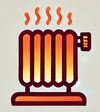Infrared heaters are known for their quiet operation, typically emitting minimal noise levels. Most models produce sounds around 30 to 50 decibels, comparable to a whisper or soft conversation. This makes them ideal for bedrooms, offices, and other quiet spaces where you want to maintain a peaceful environment.
But, factors like fan operation and heater design can influence noise levels. Some infrared heaters with built-in fans might generate slightly more sound, but even then, they’re generally much quieter than traditional heating systems. Understanding these nuances can help you choose the right heater for your needs without sacrificing tranquility.
Understanding Infrared Heaters
Infrared heaters offer an efficient way to heat spaces quietly. They do not heat air but warm objects directly, making them effective in various environments.
What Is an Infrared Heater?
An infrared heater is a space heater that uses infrared radiation. Unlike conventional heaters, which warm the air, infrared heaters target surfaces and people. This method of heating allows for faster warmth, making it ideal for quick comfort in cold settings.
How Infrared Heaters Work
Infrared heaters convert electrical energy into infrared radiation. The process involves key elements like carbon fibers, metal, or ceramic. These elements generate radiation that travels in straight lines. When the radiation hits solid objects, it gets absorbed and warms them directly.
- Heat Transfer: Infrared radiation directly heats objects rather than air. This results in a more efficient heating method.
- Efficiency: Because the radiation targets solid surfaces, it leads to quicker and more effective warmth compared to convection heaters.
Infrared heaters efficiently deliver warmth while maintaining lower noise levels, making them well-suited for any quiet space.
Importance of Noise Levels
Noise levels play a vital role in your decision-making when choosing a heating solution. Understanding how noise impacts your environment helps in selecting the right heater for your space.
Why Noise Levels Matter
Noise levels affect comfort. High noise can disrupt rest and concentration. In bedrooms or offices, a quiet heater creates a peaceful atmosphere. You might notice that some heaters produce sounds that interfere with sleep or work. For those in apartments or quiet neighborhoods, minimizing noise prevents disturbing others. Choosing a quieter option ensures harmony in shared spaces.
Impact on Comfort and Usability
Infrared heaters excel in silent operation. They lack fans and moving parts, so they typically run quietly. Standard noise levels range from 30 to 50 decibels. This is comparable to a soft conversation. Such quiet performance enhances usability in quiet settings. You can enjoy efficiently warmed spaces without the annoyance of loud noise. Infrared heaters provide direct warmth without disrupting your peace. By prioritizing low noise, you enhance your comfort and your environment.
Factors Affecting Infrared Heater Noise Levels
Several factors affect the noise levels of infrared heaters. Understanding these helps you choose the right model for your space.
Type of Infrared Heater
Types of infrared heaters play a crucial role in noise levels. Infrared heating panels, for example, produce almost no noise. They operate without fans or other moving parts. This silent design makes them different from traditional space heaters. Radiator-type heaters operate similarly. They also rely on radiation rather than convection. Both types deliver heat quietly, enhancing your comfort without disruptive sounds.
Installation and Placement
The installation and placement of infrared heaters don’t significantly impact their noise levels. Their design remains inherently quiet, regardless of where you place them. Proper placement does optimize heating efficiency, but it won’t create unwanted noise. You can install them in bedrooms, offices, or living areas without worrying about sound disturbances.
Maintenance and Usage
Maintenance and usage affect overall performance but not noise directly. Regular cleaning and inspection keep heaters operating effectively. Ensure no dust or debris obstructs heating elements. This helps maintain efficiency. Clear usage guidelines, such as avoiding high settings for prolonged periods, contribute to the longevity of the heater. Following these practices ensures a long-lasting, quiet heating source in your space.
Comparing Noise Levels of Different Models
When evaluating infrared heaters, you’ll notice key differences in noise levels among various models. Understanding these differences helps you choose the right heater for your space.
Quiet Models vs. Standard Models
Quiet models typically operate without fans. These devices, like radiant heaters, emit little to no noise. They’re ideal for bedrooms or workspaces where silence matters. On the other hand, standard models often include fans for better heat distribution. Models that feature fans can produce noticeable noise. For example, the Heat Storm Phoenix operates at 52.1 decibels on its highest setting, which is average for space heaters. In contrast, quieter models allow you to enjoy warmth without distractions.
Noise Levels Across Brands
Different brands showcase different noise levels. Dr. Infrared Heater models, such as the DR-978 and DR-998, emphasize quiet operation. They use a ball bearing low noise blower, resulting in only 39 decibels of sound. This level is often described as “whisper quiet.” Comparatively, other brands may produce higher noise levels, impacting overall comfort. Knowing the sound profile of each brand aids in making informed choices when selecting an infrared heater.
Tips for Reducing Noise Levels
Reducing noise levels from infrared heaters enhances comfort in your space. Consider the following strategies to ensure quiet operation.
Proper Installation Techniques
Place your infrared heater on a stable surface. Uneven surfaces can cause vibrations, leading to more noise. Keep the heater away from walls and furniture. This placement helps with airflow and reduces rattling sounds. If using a fan-based model, ensure it has enough space for ventilation. Proper installation makes it function smoothly and quietly.
Regular Maintenance Practices
Clean your infrared heater regularly to prevent dust buildup. Dust can cause noise by affecting the fans or heating elements. Check the fan’s blades for dirt or obstructions if your heater has one. Lubricate moving parts as needed to keep functionality smooth and silent. Follow the manufacturer’s guidelines for maintenance to ensure optimal performance. Regular upkeep minimizes noise and maximizes efficiency.
Conclusion
Choosing an infrared heater means embracing a quieter heating solution that enhances your comfort without the disruptive noise of traditional systems. With models operating as quietly as 30 decibels you can enjoy a peaceful atmosphere in any space.
By understanding the factors that influence noise levels and selecting the right model you can ensure a harmonious environment whether in your bedroom or office. Prioritizing low noise not only contributes to your comfort but also supports better concentration and relaxation.
With the right infrared heater you’ll experience efficient warmth while keeping your surroundings serene and inviting.








